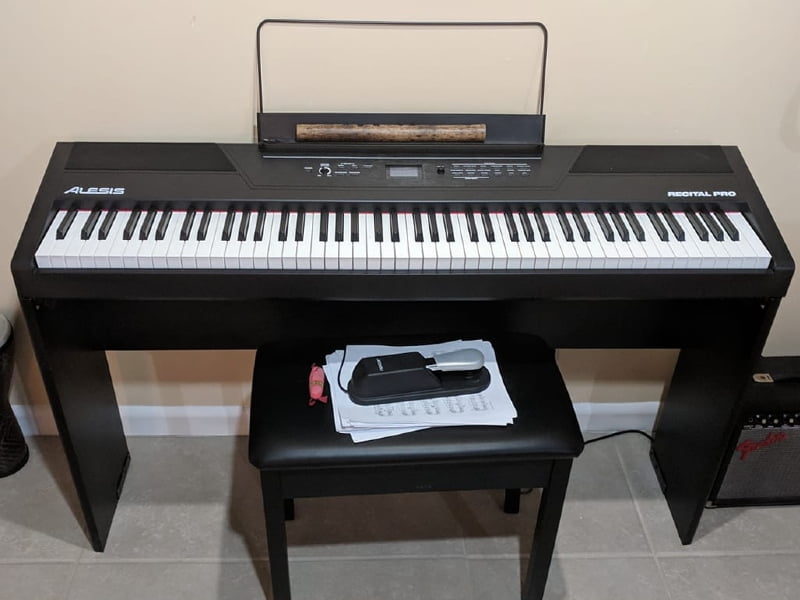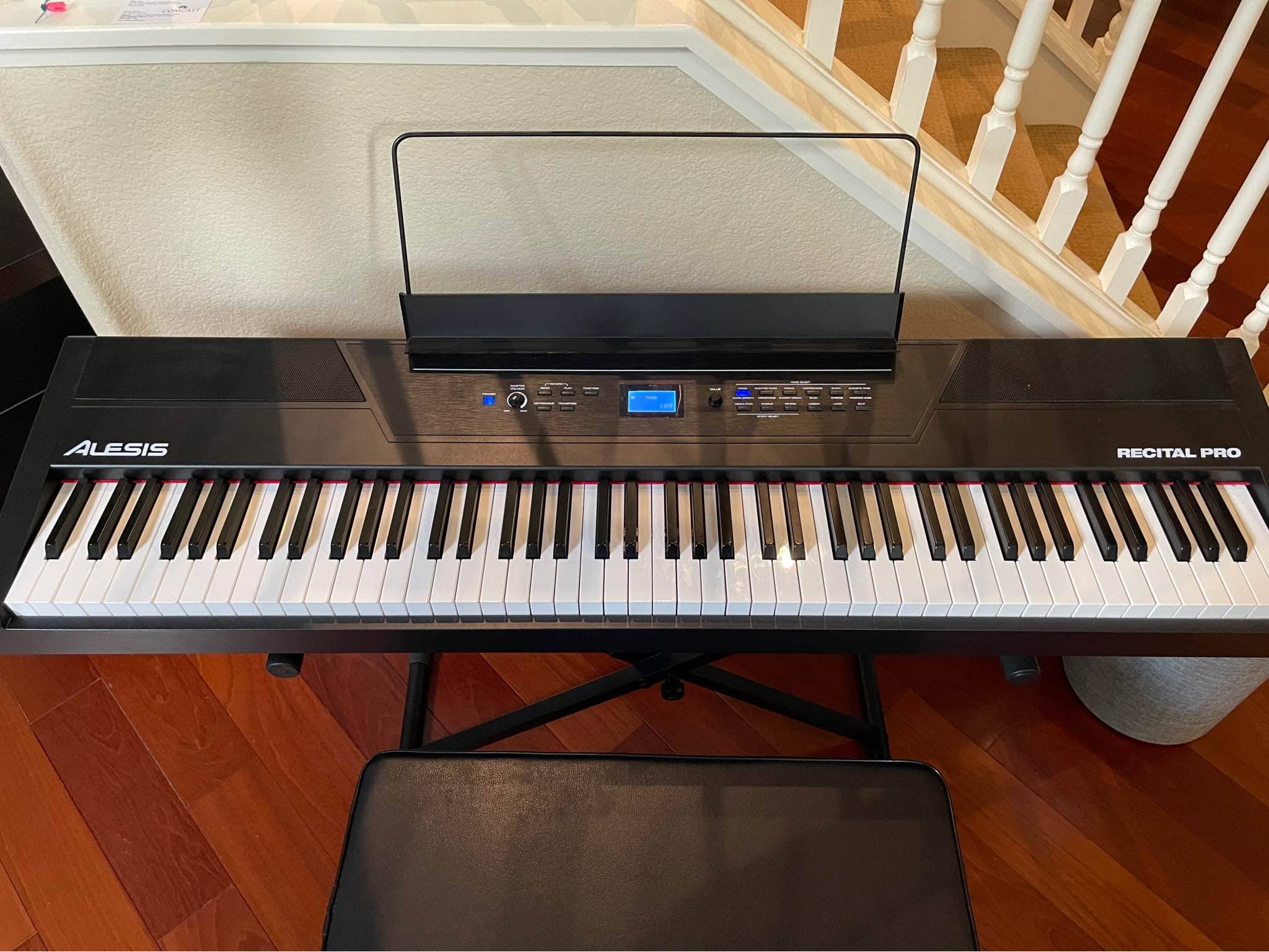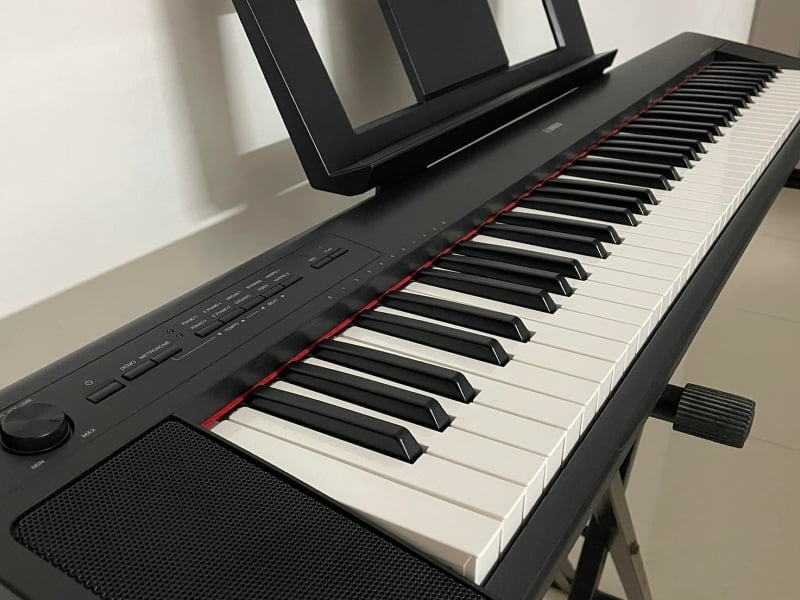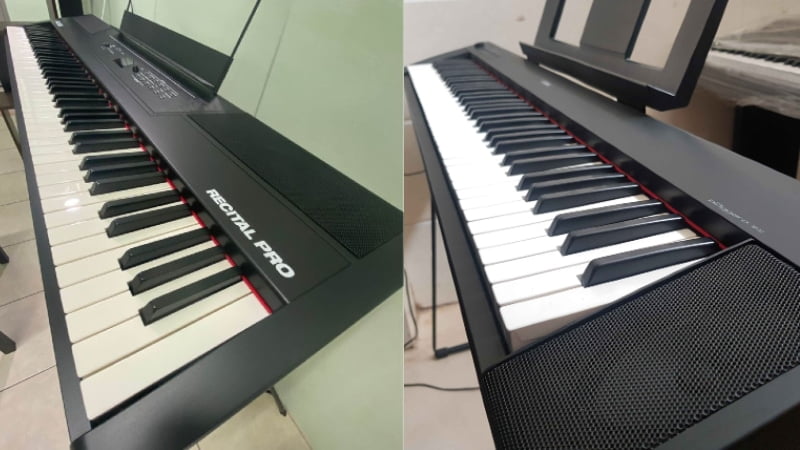Learn all the features, pros, and cons of each piano in this Alesis Recital Pro vs Yamaha NP32 comparison.
When it comes to pianos, Yamaha is one of the top brands in the industry, whether you’re getting a digital or acoustic instrument. And while Yamaha gets a lot of brand recognition, that doesn’t mean that the brand always releases the best instruments.
For example, look at the Yamaha NP32. This is a very popular entry-level model from the brand that is known for its great tones and wide range of piano features. However, when I compared it to the Alesis Recital Pro, which falls in the same price range, it fell short.
In fact, despite coming from a fairly new brand of affordable digital pianos, the Alesis Recital Pro beat out the Yamaha NP32 in just about every category. So, when shopping for digital pianos, always dive deeper than just the brand name.
If you want to learn why I found the Alesis Recital Pro to be the better option over the Yamaha NP32, you’ve come to the right place. In this Alesis Recital Pro vs Yamaha NP32 comparison, I get into all the details of each piano so you can figure out which one is the best pick for your needs.
Alesis Recital Pro vs Yamaha NP32: Comparison Chart




Last update on 2025-12-08 / Affiliate links / Images from Amazon Product Advertising API
Alesis Recital Pro vs Yamaha NP32: A Head-to-Head Comparison
Whenever I compare two digital pianos, I look at three particular categories: feel, tone, and the piano features. And in this Alesis Recital Pro vs Yamaha NP32 shootout, the Alesis swept the competition with a score of 3-0. The Yamaha NP32 put up a decent fight in just about every category, but it also fell short in each comparison. Keep reading to see exactly how the Alesis Recital Pro beats out the Yamaha NP32.
Feel & Playability
The winner: Alesis Recital Pro
Feel is the first thing you’ll notice when trying a new digital piano. Ideally, you want to get pianos that feel as close as possible to an acoustic instrument. And while both of these pianos have some sort of weighted keys, the Alesis Recital Pro easily takes the point with fully-weighted keys that offer more realistic resistance than the Yamaha NP32.

+Hammer Action
The Yamaha NP32 uses the Graded Soft Touch hammer action system. I was disappointed by this as many Yamaha pianos in this price range come with the Graded Hammer Standard or GHS. GHS is one of the most reliable and cost-effective systems available, so it’s a shame that you can’t find it on the Yamaha NP32.
Instead, you have to deal with Graded Soft Touch. This system doesn’t give weight to the keys. The Graded Soft Touch system has rubber and silicon underneath the keys to measure the pressure you’re playing with. So, if you press down harder, you get more volume, and vice versa.
These keys require a bit more pressure than the non-weighted keys you may find on a synthesizer. But when it comes to replicating how an acoustic piano feels, it falls short.
The Alesis Recital Pro, on the other hand, features fully weighted keys. That way, playing this piano feels very similar to playing an acoustic piano, which is one of the main reasons the Alesis Recital Pro offers lots of value for the money. And when you compare this system to the Yamaha NP32, the Alesis is the clear winner.
Tone
The winner: Alesis Recital Pro
After testing how the pianos felt, I had to determine how they sounded. The Yamaha NP32 produces high-quality, bright tones that you’d expect from the brand. That said, it has a very limited sound library and only has 77 keys, which limits your range. So, it couldn’t steal the point from the Alesis Recital Pro in this category.
+Tone Generation
In terms of tone generation, both of these pianos are tied. Both models utilize a sample-based tone generator. So, the pianos come loaded with recordings of real instruments that you can trigger whenever you press a key.
And while sampling is one of the most basic forms of tone generation for digital pianos, the Alesis and Yamaha models exceeded expectations. I couldn’t find that much information on the samples loaded into the Alesis, but after an ear test and looking at other expert opinions, I found that the Alesis has tones that beat out most in its price range.
The Yamaha NP32, on the other hand, uses the AWM sampling method. This is the way that most budget-friendly Yamaha pianos produce really rich tones. These samples are much more detailed and contain dense information, which means you get really rich and full sounds from the piano.

+Sound Library
While the Alesis Recital Pro and Yamaha NP32 have comparable sound quality, the sound libraries are different. The Yamaha NP32 offers a basic selection of 10 voices. These include all the essentials, like a selection of various pianos, strings, and organ voices.
If you’re a beginner, these are all the voices you need. But if you want to have a bit more control over your piano’s sound, the 16-voice library of the Alesis Recital Pro might suit you better. This isn’t that much larger than the Yamaha NP32’s library, but the six extra voices allow you to explore different musical styles and tailor the tone to your ears.
Piano Features
The winner: Alesis Recital Pro
The last comparison point I had between these two pianos was the piano features. Specifically, I looked at the playing modes and polyphony. And again, the Alesis Recital Pro was the clear winner, with more playing modes and higher polyphony to present many more possibilities than the Yamaha NP32.
+Playing Modes
The Yamaha NP32 only comes with one additional mode, which is duo mode. This feature is designed for beginners as it divides the piano into two zones loaded with the same voice. That way, a teacher and student can play at the same time without worrying about pitch differences, making it much easier to demonstrate techniques and guide the pupil.
On top of that, you can use this mode for piano duets when there’s only one keyboard available. However, remember that this is only a 77-key piano, so your range is very limited with this mode.
The Alesis Recital Pro also comes with duo mode, which is much better on this piano since you have 88 keys. You can also use the layering mode to combine two voices to produce a new and unique tone. This is great for experimentation and makes a huge difference when performing live.
+Polyphony
The Yamaha NP32 is designed to be a very basic piano. So, it only comes with 64-note polyphony. This is great for beginners and even novices as it allows you to play with a lot of emotion and many notes simultaneously.
However, the Alesis Recital Pro is a more modern option with 128-note polyphony. You probably won’t need this as a beginner, but the polyphony makes a bigger difference as you get better at the piano. So, the Alesis Recital Pro is the better option if you’re looking for a piano that can handle your playing for many years to come.

Alesis Recital Pro vs Yamaha NP32: The Similarities
These pianos have many differences. That said, there are still some similarities that many people notice with these instruments. For example, they are both portable and relatively lightweight. This is great for beginners as you can easily bring the piano with you to lessons, rehearsals, and jam sessions.
Additionally, these are both some of the most affordable digital pianos on the market. If you want to buy your first digital piano and don’t want to bust the bank, these are great picks. However, there’s no doubt in my mind that the Alesis Recital Pro offers more value for the money.
Quick Rundown of the Alesis Recital Pro
- A Digital Piano That’s Tailored to You - Feature-packed Electric keyboard with 88 premium full-sized weighted hammer action keys with adjustable touch response to suit your preferred playing style
- Premium Sounds - 12 voices (Incl. Acoustic Piano, Electric Piano, Organ, Synth, and Bass), built-in FX: Chorus, Modulation, Reverb, and two built in 20W speakers for clear, room-filling sound
- All The Right Connections - ¼” sustain pedal input (pedal not included), ¼” stereo headphone output for private practice and stereo outputs for connection to speakers / amplifiers
- Play the Keyboard Wherever You Go - Power via the included power adapter or 6 D cell batteries (not included) for professional piano performance anywhere
- Powerful Educational Features - Standard, split, layer, record and lesson modes with 128-note max polyphony and Skoove 3 month premium subscription for expert interactive online piano lessons
Last update on 2025-12-08 / Affiliate links / Images from Amazon Product Advertising API
Quick Rundown of the Yamaha NP32
- 76-Key Graded Soft Touch (GST) keyboard action provides gentle weighting, whilst retaining the soft touch of a digital keyboard
- Advanced Wave Memory Stereo Sampling recreates natural instrument sound in stereo
- The controller App for iOS adds a rich, graphic user interface allowing for quick and easy navigation and configuration
- The USB to Host port allows you to connect and interact with a wide variety of educational and musical creation Apps on a computer or mobile device
- Additional upgrades include 64-note polyphony, a song recorder function, and extended battery life
Last update on 2025-12-08 / Affiliate links / Images from Amazon Product Advertising API
Product Videos
Related Articles to Alesis Recital Pro
- Alesis Recital Pro vs Williams Legato III: Discover the Best Piano for Your Home
- Alesis Recital Pro vs Roland Go Piano 88 Comparison: Which Is The Best Portable Digital Piano?
- Kawai ES110 Vs Alesis Recital Pro: Should You Shell Out for the Kawai ES110?
- Alesis Recital Pro vs Prestige Comparison: Choosing the Best Entry-Level Alesis Piano
- Alesis Recital Pro vs Casio CDP-135: Which Is the Best Beginner’s Digital Piano?
- Alesis Recital Pro vs Roland FP-30: Finding the Best Digital Piano on a Budget
- Alesis Recital Pro vs Casio CDP-S150 Comparison: Which Is The Best Portable Digital Piano?
- Alesis Virtue vs Recital Pro: Which Piano Offers The Most For Beginners?
- Alesis Recital Pro vs Casio PX 160: Which Piano Comes Out On Top?
- Alesis Recital Pro vs Roland FP 10: Why You Should Go For The Alesis Recital Pro
- Alesis Recital Pro vs Korg B2 Comparison: Which Digital Piano Should You Get?
- Alesis Recital Pro vs Williams Allegro 3 Comparison: Which One Is Worth Your Money?
- Alesis Recital Pro vs Yamaha P125 Comparison: Which Is The Best Portable Digital Piano?
- Alesis Recital vs Alesis Recital Pro: Should You Invest In The Recital Pro?
- Alesis Recital Pro vs Yamaha P45: Which Should You Get As Your First Piano?
- Donner DEP-20 vs Alesis Recital Pro Comparison: Two Great Pianos Designed for Beginners
- Alesis Prestige Artist vs Recital Pro: Which Is the Best Alesis Piano for Beginners?
- Yamaha P71 vs Alesis Recital Pro: Which Digital Piano is the Best Option for Beginners?
Related Articles to Yamaha Np32
- Yamaha P45 Vs NP32: A Head-to-Head Comparison
- Alesis Recital Vs Yamaha NP32: Which Is Better For Beginners?
References:
- Alesis Recital Pro: https://www.alesis.com/products/view/recital-pro
- Yamaha NP32: https://usa.yamaha.com/products/musical_instruments/keyboards/piaggero/np-32_12/specs.html#product-tabs
Lulacruza is an electronic folk duo operating at the junction of the hypermodern and the ancient. Our music weaves together hypnotic female singing, South American folk instruments and electronic processing, while channeling pulsating waves from the source of creation.
Lalucruza is also a community where you can connect with other music lovers to collaborate, exchange ideas and share knowledge. A platform for who wants to learns the basics of playing piano, guitar, drum masters’ technique, etc.. is the premise of our website.
